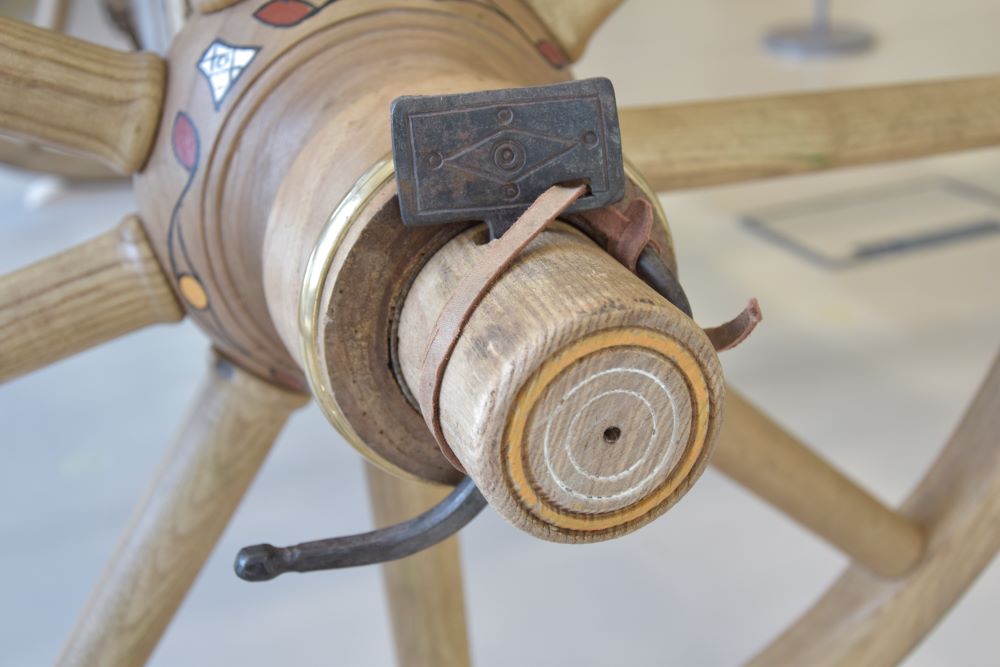A full-size replica chariot from the Iron Age has gone on display at the University of Nottingham Museum at Lakeside Arts, as part of the Life at an Iron Age Hillfort: Investigating Breedon Hill & Burrough Hill exhibition.
The chariot is the latest addition to the free archaeological exhibition, which opened in January this year and runs until 13 July 2025, and brings together fascinating items discovered during excavations at Breedon Hill and Burrough Hill hillforts, both in Leicestershire.
Chariot-maker Robert Hurford, crafted the replica, which has gone on display just in time for visitors to enjoy over the Easter holidays, where they are invited to travel back in time to the Iron Age.

Robert, a reconstructor of ancient vehicles and a wheelwright, has been researching and building medieval and ancient vehicles for 50 years, following a childhood ambition. He made his first chariot in 2001 to illustrate a chariot burial discovered in Yorkshire for BBC2's Meet the Ancestors, basing his design on the excavation results which revealed soil colourations to suggest the probable position of the wooden parts.
With help from the British Museum the craftsman brought together ideas and materials – including ash, rawhide, iron and bronze – for the construction from sources including the tiny number of existing chariots (mostly Egyptian), and from depictions on Gallic coins, and stones carved with images from Celts in Italy.
We have actually driven chariots like this with pairs of ponies (the horses were small in those days), but the real challenge is using an ancient harness and the yoke - a different experience for the driver and the horses. It requires well trained ponies and a high degree of horsemanship!"
Along with a range of ancient everyday objects from both hillforts, the replica chariot now joins a spectacular hoard of chariot fittings already on display. The finds from Breedon Hill were recovered during excavations in advance of quarrying between the 1940s–1960s by pioneering archaeologists Dame Kathleen Kenyon and John Wacher; while the Burrough Hill artefacts are from several excavations at the hillfort, most recently by archaeologists and students from the University of Leicester, between 2010-2014. These finds are cared for by Leicestershire County Council Museums who have loaned them for the exhibition.
Dr Clare Pickersgill, Keeper of the University of Nottingham Museum, said: "I am delighted that we can display this incredible chariot made by Robert. It is a special opportunity to be able to see the chariot, displayed alongside The Burrough Hill Hoard, which includes decorated bronze and iron chariot fittings and horse harness fittings. Together they provide an insight into the skills and craft of this period."
Alongside the exhibition there continues a fascinating and varied Public Programme of events which includes a talk, The Hallaton Helmet: A Conquest Period Mystery, where Helen Sharp, Curator of Archaeology at Leicestershire County Council Museums, will discus the Roman cavalry helmet from the Hallaton Treasure, on 11 June 2025 at the Djanogly Theatre; and Dr Sophia Adams, Curator at the British Museum, will examine the significance of ponies in Iron Age Britain in the talk Vibrant Vestiges of Vehicles: The Power of Ponies in Iron Age Britain, on 3 July 2025 at the Djanogly Theatre.
The exhibition runs until Sunday 13 July 2025 at the University of Nottingham Museum, Lakeside Arts, and admission is free. Opening times, 12 noon-4pm Thursday to Sunday. Closed Monday to Wednesday.






